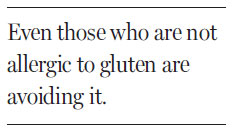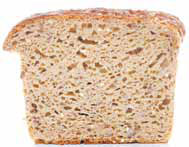Saying goodbye to wheat
Updated: 2013-02-17 08:39
By Kenneth Chang(The New York Times)
|
|||||||
|
Some say avoiding gluten is just another dietary fad. Tony Cenicola / The New York Times |

Eat no wheat.
That is the core, draconian commandment of a gluten-free diet, a prohibition that excises foods like cupcakes, pizza and bread.
For the approximately one in 100 Americans who have a serious condition called celiac disease, that is an indisputably wise medical directive. And the disorder affects people all over the world.
Now medical experts largely agree that there is a condition related to gluten other than celiac. In 2011 a panel of celiac experts convened in Oslo and settled on a medical term for this malady: non-celiac gluten sensitivity.
What they still do not know: how many people have gluten sensitivity, what its long-term effects are, or even how to reliably identify it.
The definition is less a diagnosis than a description - someone who does not have celiac, but whose health improves on a gluten-free diet and worsens again if gluten is eaten. It could even be more than one illness.
"We have absolutely no clue at this point," said Dr. Stefano Guandalini, medical director of the University of Chicago's Celiac Disease Center.
Kristen Golden Testa could be one of the gluten-sensitive. Although she does not have celiac, she adopted a gluten-free diet last year. She says she has lost weight and her allergies have gone away. "It's just so marked," said Ms. Golden Testa, who is health program director in California for the Children's Partnership, a national nonprofit advocacy group.
Ms. Golden Testa did not consult a doctor before making the change and does not know whether avoiding gluten is what has helped. "This is my speculation," she said. She also gave up sugar at the same time and made an effort to eat more vegetables and nuts.
Many advocates of gluten-free diets warn that non-celiac gluten sensitivity is a wide, unseen epidemic undermining the health of millions of people. They believe that avoiding gluten - a composite of starch and proteins found in certain grassy grains like wheat, barley and rye - gives them energy and alleviates chronic ills.
Others see the popularity of gluten-free foods as just a fad, destined to fade like the Atkins diet and the avoidance of carbohydrates a decade ago. Indeed, Americans are buying billions of dollars of food labeled gluten-free each year."
It is not a healthier diet for those who don't need it," Dr. Guandalini said. These people "are following a fad, essentially."
Nonetheless, he agrees that some people who do not have celiac receive a health boost from a gluten-free diet. He just cannot say how many.
As with most nutrition controversies, most everyone agrees on the underlying facts. Wheat entered the human diet only about 10,000 years ago, with the advent of agriculture.
The primary proteins in wheat gluten are glutenin and gliadin, and gliadin contains repeating patterns of amino acids that the human digestive system cannot break down. (Gluten is the only substance that contains these proteins.)
People with celiac have one or two genetic mutations that somehow, when pieces of gliadin course through the gut, cause the immune system to attack the walls of the intestine. That, in turn, causes fingerlike structures called villi that absorb nutrients on the inside of the intestines to atrophy, and the intestines can become leaky, wreaking havoc.
What worries doctors is that the problem seems to be growing. Some blame the wheat, as some varieties now contain higher levels of gluten, because gluten helps provide the springy inside and crusty outside desirable in bread.
Celiac experts urge people to not self-diagnose. Should they actually have celiac, the tests to diagnose it become unreliable if one is not eating gluten.
The New York Times
(China Daily 02/17/2013 page11)
